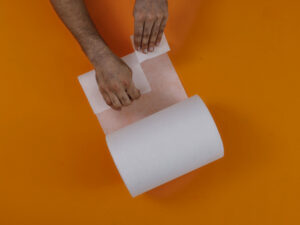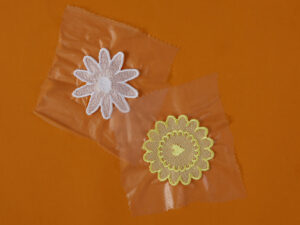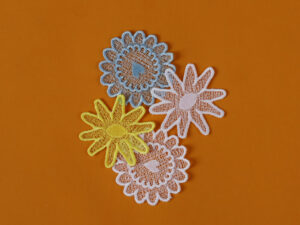Cutaway Stabilizers
Cutaway stabilizers are soft, non woven stabilizers, that support the embroidered design through the life of the garment. They are used for unstable garments or fabrics such as knit, fleece, lightly woven or stretchy fabrics.
A good rule of thumb is; if your fabric stretches, you use cut-away stabilizers. There are also woven cutaway stabilizers available specifically used for performance wear.
Caption 1: Cutaway Stabilizers
Tearaway Stabilizers
As the name suggests, we tear away the stabilizer after embroidering. Like Cut Away stabilizers tear away stabilizers also support the design through out the life of the garment.
Tear away stabilizers are best for when we don’t want the stabilizer to show. Example with towel, caps, bags, etc.
Caption 2: Tearaway Stabilizers
They offer light support to stable fabrics; caps, leather, denim, twill or canvas. Make sure when you start tearing away the stabilizer you place your finger on the stitches and tear it away from the stitch instead of toward the stitch.
Washaway Stabilizers
Wash-away stabilizers are known for their resilience, transparency, and water solubility. Water-soluble stabilizers come in clear films of light or heavy weights or fibrous material. Ideal for creating patches as well.
The stabilizer is easily removed away without distorting stitches or harming the design after wetting.
When To Use Washaway Stabilizers
Wash away stabilizers are used when you do not want any residual stabilizers left over an embroidered garment. Sheer fabrics and organza are fabrics where one wouldn’t want to see a stabilizer. Other instances where it can be used are free standing laces, 3D and cutwork designs.
They are best used with super stretchy and slippery fabrics such as Lycra and Spandex. But they are not suitable for dry clean only fabrics.
How To Use Washaway Stabilizers
First you have to hoop the soluble stabilizer, and embroider the design. Then you cut off the excess stabilizer. Once done, the stabilizer that is embroidered will be soaked and dissolved in water, leaving behind the stitches. The temperature of the water depends on the type of stabilizer. Some stabilizers dissolve in warm water and others in cold.

Caption 3: Water soluble stabilizers for free standing lace
Removing Washaway Stabilizer
Remove as much stabilizer as possible by tearing or cutting away the excess. Then immerse or rinse the project under running water until all traces of the stabilizer are removed. Be mindful the temperature of the water is in accordance to the instructions of the stabilizer.
If using a machine, place your finished piece in a mesh laundry bag and wash it on a gentle cycle. Avoid using harsh detergents or bleach as they can damage the fabric. After removing your stabilizer, air dry the fabric flat to prevent distortion. When creating lace, the more it is washed, the softer the lace will be
Heataway Stabilizers (Films)
This is a plastic-like film which is Heat dissolving, mainly used for embroidery as a temporary stabilizer which disintegrates with ironing. Heat-away stabilizer also tears away easily but requires direct heat to disappear. Heat away is preferred over washday stabilizers because of its easier removal process.
Best Use Of Heataway Stabilizers
Heat-Away Embroidery Stabilizer is an excellent option when water is not an option for removing the stabilizer, or when tearing the stabilizer could damage the fabric or when you do not want residue left on the fabric. Such fabrics are; satin, wool and velvet.
They are best used for stand-alone applications. Embroider directly on film to create stand-alone patches, badges and emblems that are perforated and popped out. Excess material can be removed with a heat gun or heat press.
How To Remove Heataway Stabilizer
To remove the stabilizer from the fabric, you just need to use hot dry iron. The residue can be easily brushed away. The transparent film that remains after ironing is concealed. It will permanently reside amidst the embroidery threads and fabric.
Small design areas (e.g., letters like o, b, or d) can be challenging for heat pressing. Use the tip of an iron set on a silk setting to touch and make the topping disappear.




